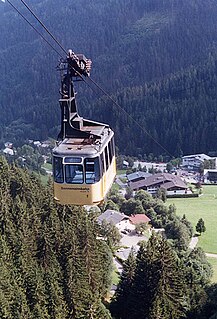
Cable transport is a broad class of transport modes that have cables. They transport passengers and goods, often in vehicles called cable cars. The cable may be driven or passive, and items may be moved by pulling, sliding, sailing, or by drives within the object being moved on cableways. The use of pulleys and balancing of loads moving up and down are common elements of cable transport. They are often used in mountainous areas where cable haulage can overcome large differences in elevation.

Logging is the process of cutting, processing, and moving trees to a location for transport. It may include skidding, on-site processing, and loading of trees or logs onto trucks or skeleton cars.

An aerial tramway, sky tram,cable car, ropeway or aerial tram is a type of aerial lift which uses one or two stationary ropes for support while a third moving rope provides propulsion. With this form of lift, the grip of an aerial tramway cabin is fixed onto the propulsion rope and cannot be decoupled from it during operations.

A skid loader, skid-steer loader, SSLs or skidsteer is a small, rigid-frame, engine-powered machine with lift arms that can attach to a wide variety of buckets and other labor-saving tools or attachments.

An elevated passenger ropeway, or chairlift, is a type of aerial lift, which consists of a continuously circulating steel wire rope loop strung between two end terminals and usually over intermediate towers, carrying a series of chairs. They are the primary onhill transport at most ski areas, but are also found at amusement parks, various tourist attractions, and increasingly in urban transport.

A garbage truck is a truck specially designed to collect municipal solid waste and transport it to a solid waste treatment facility, such as a landfill, recycling center or transfer station. Other common names for this type of truck include trash truck in the United States, and refuse truck, dustcart, rubbish truck, junk truck, bin wagon, dustbin lorry, bin lorry or bin van elsewhere. Technical names include waste collection vehicle and refuse collection vehicle (RCV). These trucks are a common sight in most urban areas.

Heavy equipment or heavy machinery refers to heavy-duty vehicles, specially designed for executing construction tasks, most frequently ones involving earthwork operations or other large construction tasks. Heavy equipment usually comprises five equipment systems: implementation, traction, structure, power train, control and information.

A skidder is any type of heavy vehicle used in a logging operation for pulling cut trees out of a forest in a process called "skidding", in which the logs are transported from the cutting site to a landing. There they are loaded onto trucks, and sent to the mill. One exception is that in the early days of logging, when distances from the timberline to the mill were shorter, the landing stage was omitted altogether, and the "skidder" would have been used as the main road vehicle, in place of the trucks, railroad, or flume. Modern forms of skidders can pull trees with a cable/winch, just like the old steam donkeys, or a grapple or a clam-bunk.

A feller buncher is a type of harvester used in logging. It is a motorized vehicle with an attachment that can rapidly gather and cut a tree before felling it.

Sugarloaf is a ski area and resort located on Sugarloaf Mountain in Carrabassett Valley, western Maine. It is the second largest ski resort east of the Mississippi in terms of skiable area and snowmaking percentage (95%); its continuous vertical drop of 2,820 feet (860 m) is the second longest in New England. Sugarloaf recorded a total of 352,000 skier visits in the 2005–2006 season, ranking it second among Maine resorts and 11th in New England.
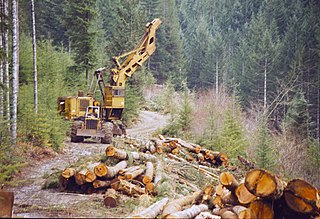
A swing yarder is a mobile piece of heavy duty forestry equipment used for pulling logs from the woods to a logging road with cables. The swing yarder is also known as a grapple yarder.

A grapple is a hook or claw used to catch or hold something. A ship's anchor is a type of grapple, especially the "grapnel" anchor.
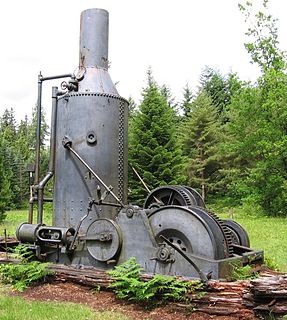
A steam donkey or donkey engine was a steam-powered winch once widely used in logging, mining, maritime, and other industrial applications.

A fly system, or theatrical rigging system, is a system of rope lines, blocks (pulleys), counterweights and related devices within a theater that enables a stage crew to fly (hoist) quickly, quietly and safely components such as curtains, lights, scenery, stage effects and, sometimes, people. Systems are typically designed to fly components between clear view of the audience and out of view, into the large opening, known as the fly loft, above the stage.

A yarder is piece of logging equipment that uses a system of cables to pull or fly logs from the stump to a collection point. It generally consists of an engine, drums, and spar, but has a range of configurations and variations, such as the swing yarder.
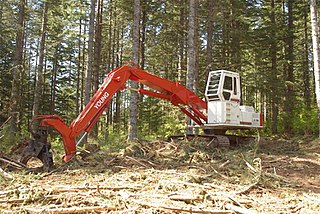
Shovel logging, sometimes called Hoe Chucking, uses a log loader to swing logs to the forest road. Shovel logging is one of a number of methods that may be used to move logs from forest to road. Rather than driving out to the log and dragging it back to the landing, the loader moves slowly across the harvest area, grabbing logs/trees within reach, and swinging them around to drop them closer to the road. Logs further from the road can be shoveled to the landing in a few passes back and forth.
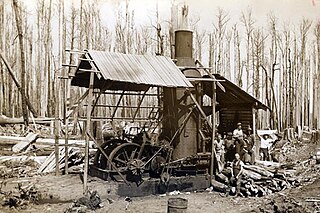
The Washington Winch sits in the forests of eastern Victoria near Swifts Creek and is also known as the Washington Iron Works Skidder.
The following outline is provided as an overview of and guide to forestry:

Heli-logging, or helicopter logging, is a method of logging that uses helicopters to remove cut trees from forests by lifting them on cables attached to a helicopter. Helicopter logging is often used in inaccessible areas of forests. Because the use of helicopters reduces the level of infrastructure required to log in a specific location, the method also helps to reduce the environmental impact of logging. It also can increase the productivity in these remote areas.

A glider or sailplane is a type of glider aircraft used in the leisure activity and sport of gliding. This unpowered aircraft can use naturally occurring currents of rising air in the atmosphere to gain altitude. Sailplanes are aerodynamically streamlined and so can fly a significant distance forward for a small decrease in altitude.





















